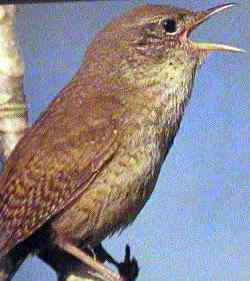House Wren
From Wikipedia, the free encyclopedia
[Photo] House Wren from US NPS. Source: U.S. National Park Service, Isle Royale National Park
The House Wren, Troglodytes aedon, is a small songbird of the wren family.
Their breeding habitat is semi-open areas from Canada to southernmost South America. The tropical forms from southern Mexico southwards are sometimes considered a separate species, the Southern House Wren, Troglodytes musculus. Birds on the Falkland Islands are now often considered to be an endemic species, Cobb's Wren, Troglodytes cobbi. North American birds migrate to the southern United States and Mexico.
This bird usually builds a large cup nest in various sorts of cavities, either natural or man-made, often using bird houses where they are available, and sometimes choosing unusual sites such as old shoes. The female incubates the clutch of three to six red-blotched cream-white eggs for 14-15 days, and the naked young take another 16-19 days to fledge.
House Wrens are known to occasionally destroy the eggs of other birds nesting in their territory by breaking the eggshell.
Adults are 11.5 cm long and weigh 12 g. They have brown or grey-brown upperparts with pale grey-brown underparts; there are black bars on the flanks, wings and tail. They have an eye ring, a faint line over the eye, a short thin bill and pink legs.
There are regional variations in the appearance of this bird. The subspecies found on Tobago, T. a. tobagensis is larger and has much paler underparts than the mainland forms.
These birds forage actively in vegetation. They mainly eat insects such as butterfly larvae, also spiders and snails.
This bird's rich bubbly song is commonly heard during the nesting season but rarely afterwards. The birds can be encouraged to nest in gardens in their range by offering nest boxes with hole small enough to prevent competitive cavity nesters.
The House Wren may have been displaced somewhat in some northern parts of its range by the introduction of the House Sparrow but is still common and widespread throughout most of the two continents. In North America, they are thought to achieve their highest densities in floodplain forests in the western great plains where they use woodpecker holes as nesting sites.
http://en.wikipedia.org/wiki/House_Wren
| The text in this page is based on the copyrighted Wikipedia article shown in above URL. It is used under the GNU Free Documentation License. You may redistribute it, verbatim or modified, providing that you comply with the terms of the GFDL. |
|

